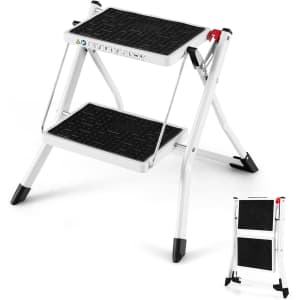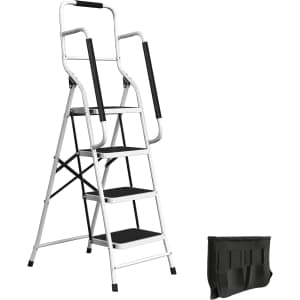
This Lowe's daily deal costs $44 less than Home Depot's price. Buy Now at Lowe's
- 300-lb. load capacity
- average reach height of 8.4-ft., based on 5' 7" person with 12" reach
- Model: NXT1A04

There are three to choose from, discounted by between $23 and $35 off. We've picked out this Little Giant Ladders Multi M14 14.3-Foot Telescoping Multi-Position Ladder for $159 ($35 off.) Shop Now at Lowe's

Save $15 and make sure you're prepared to reach all those... well, those hard-to-reach places around your house. Buy Now at Amazon
- anti-slip feet and step coverings
- 330-lb. weight capacity
Ladders: The Basics
Ladders help get you to high places — whether that be your roof or just the top shelf of your pantry — and getting places is an inherently useful trait.
If you’re considering buying one, it’s essential to know where to shop for the best cheap ladder deals, how to pick the right one, and perhaps most importantly, how to properly and safely use said ladder. We’ve compiled this information here to help in your ladder purchasing quest.
Notable Ladder Brands
Popular Stores for Cheap Ladders and Ladder Sales
Common Ladder Types and Their Uses
Twin Step Ladder: Your stereotypical household ladder and all around reliable go-to. Consists of twin steps and is self supporting. Suitable for most indoor tasks, and some outdoor tasks that don’t require a great deal of height.
Extension Ladder: An extension ladder can reach greater heights. It’s generally single-step and does not offer self-support, which means it must be positioned against a support structure in order to be used. Its extendable nature makes it ideal for outdoor projects that require significant upward reach — such as painting the exterior of a house, or doing roof maintenance.
Multipurpose Ladder: A combination of the twin step and extension ladder. Useful if your needs may require both of the above. However, if pure height is specifically important, a dedicated extension ladder is likely to be needed. Multipurpose ladders can also feature points of articulation, making them suitable for use as scaffolding.
Step Stool: Its exact classification as a ladder may be disputed, but functionally its purpose is the same (on a smaller scale). For just a small boost, a step stool might be what you need.
For much more on various ladder types and how to choose one that is right for you, you can refer to our previously written article on this very subject.
Ladder Safety
Did you know that according to a 2014 report by the CDC , 43% of fatal falls in the last decade have involved a ladder? We’re all at the mercy of gravity and therefore safety is paramount. It starts with choosing the right ladder for the job (in terms of height, weight capacity, and environment), and then making sure you know how it works best.
Top 2 Ladder Rules to Remember:
- For every 4 feet of a single step ladder’s length, you should move it one foot away from the surface it’s resting on.
- Always maintain three points of contact with the ladder. Two hands and one foot or two feet and one hand.
Consideration should also be given to environmental factors that may have a detrimental effect on the safe operation and use of your ladder. If the surface you’re using is wet, the base of the ladder and your own points of contact may not be able to get enough friction for a good grip. If you’re outside, high winds may hamper the ability to properly balance yourself or the ladder.
For more safety tips, it’s worth looking over the advice provided by the National Safety Council .
Frequently Asked Questions
What is a ladder?
According to the folks at Merriam-Webster , a ladder is “a structure for climbing up or down that consists essentially of two long sidepieces joined at intervals by crosspieces on which one may step.”
That said, a ladder is a tool that is specifically made to help you reach high places in relative safety. Your dining room chair is not a ladder!
When were ladders invented?
The exact origin of ladders is unclear. According to the BBC , ladder-like pictures were discovered in a cave in Spain dating back to over 10,000 years. More specifically (and more recently), John H. Balsley is credited with the creation of the modern step ladder in 1862.
What should I look for in a ladder?
On a basic level, your ladder needs to be made of a sturdy material, able to hold the expected weight it’ll be subjected to, and (ideally) produced by a recognised brand. All of these things will help to make it as safe as possible to use. Beyond that, it should be fit for the purpose you’re going to use it for; not all ladders are intended to be used in the same way for the same task.
What should a ladder be made of?
There’s a few commonly used materials. Wood is a traditional choice, but it’s heavy, subject to the ravages of time, slippery when wet, and can conduct electricity. Aluminum, on the other hand, is lighter, more durable over time, and cheaper. However, aluminum also conducts electricity.
If you aren’t going to be working near a power source or electric lines, aluminum is likely a good material for your ladder. If you are, then spend more and go for a fiberglass ladder, which has all the strengths of aluminium while also being non-conductive — and therefore safe to use around electricity sources.
What are the most highly regarded ladder brands?
As we noted, Gorilla, Werner, Louisville, and Little Giant are among the most commonly recommended and highly reviewed brands.
How important is ladder safety?
Extremely! There are numerous reported ladder accidents every year. But if you follow safety guidelines closely you can significantly reduce the likelihood of any harm occurring. We’ve listed some such guidelines above, and you can (and should) visit the National Safety Council ’s website for more information.
How important is a ladder’s weight limit?
Weight limits exist to be abided by. An important thing to keep in mind when considering ladder weight limits is if you plan on carrying anything of notable weight while using the ladder, you will need to take that into consideration ahead of time. Otherwise, you may inadvertently exceed the weight limit.
Niall is an English Literature graduate who has been part of the Irish DealNews team for a number of years. He mainly coordinates client content and sponsored items. When not doing that, he’s continuing his undefeated office reign in Mario Kart.
